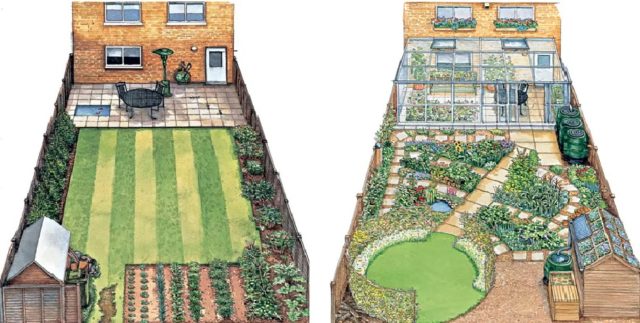How To Eco-Fit Your Garden

In an extract from his new book, ‘How to Create an Eco Garden’, John Walker explains how to turn an unassuming urban plot into an eco-friendly haven.
What is garden eco-fitting?
Eco-fitting is the updating of any existing elements and the addition of new ones that were not there when the garden was originally made. Before you set about eco-fitting, first spend some time noting down how environmentally friendly you think your garden might currently be.
Eco-fitting your garden is all about making it more self-sustaining, less wasteful, more reliant on renewable sources of energy and friendlier to wildlife. Eco-fitting will turn a garden that was drab, uninteresting and lifeless into a space that is biologically diverse, beautiful, productive and much more planet-friendly. The basic tenets of eco-friendly gardening are:
- Recycle all garden waste through composting.
- Reduce garden energy use.
- Harness and use sunlight energy.
- Harvest rainwater and use it wisely.
- Improve soil with garden compost and green waste.
- Create a thriving garden ecosystem by adding habitats and encouraging wildlife.
- Grow flowers to attract beneficial pest-controlling insects and boost biodiversity.
- Mulch to conserve soil moisture and stop weed seeds from germinating.
- Create areas for play and relaxation.
- Grow some of your own food.
- Use reclaimed, recycled and sustainable landscaping materials.
- Avoid use of synthetic insecticides, fungicides and weedkillers.
You might already implement some of these eco-friendly practices but much of the enjoyment of eco-gardening is in deciding where to add more. You do not have to carry out an eco-fit all at once – adding a lean-to greenhouse is a major undertaking – but simply growing more flowers to attract beneficial insects can give immediate rewards.
Before eco-fitting
1. A gas-powered patio heater releases the polluting greenhouse gas carbon dioxide.
2. Energy-intensive mains tap water is used for watering and for running a lawn sprinkler.
3. Goldfish dominate the small pond at the expense of wildlife.
4. An overgrown x Cupressocyparis leylandii hedge has been cut down, leaving ugly stumps. Its roots have starved the soil.
5. Lawn mowing uses fossil fuel, creating air and noise pollution and more work.
6. Dry and bare border soil, routinely sprayed with weedkiller, has little appeal for wildlife. Double nectarless flowers attract few insects.
7. In the vegetable plot, crops grow in poor, dry soil. Synthetic fertilizers encourage sappy, pest- and disease-prone growth; plants are sprayed regularly with pesticides and slug pellets are used.
8. Valuable garden and kitchen waste is binned and lost to municipal composting.
9. Rainwater runs off the shed roof.
After eco-fitting
1. A lean-to greenhouse warms up as it absorbs sunlight energy, creating a space in which to grow edible and ornamental plants; some slabs are removed to create soil beds. Heating is not used during winter, when only frosthardy food crops are grown.
2. Herbs near the house are convenient to harvest.
3. Rainwater from the greenhouse roof is stored in linked water butts.
4. The lawn is replaced by a decorative kitchen garden. Vegetables, fruit and herbs intermingle with flowers rich in pollen and nectar, which attract beneficial pollinating and pest-eating insects. The paths are made of reclaimed natural stone. Columnar fruits utilize vertical growing space.
5. An insect hotel attracts solitary bees and other useful insects.
6. Espalier apples and pears and currant cordons are now trained on the fence. The hedge has been removed and the soil improved.
7. Slug-eating frogs breed in a fish-free wildlife pond.
8. Log piles create a wildlife habitat.
9. A living willow “fedge” encloses a grass play area, edged by uncut grass and wildflowers. A simple push mower is used.
10. Wood chips are used as a mulch between the stepping stones; weedkiller is not used (or required).
11. Rainwater fills a recycled plastic water butt.
12. All garden and kitchen waste is composted in recycled wooden bins, then returned to the garden to improve the soil.
13. The rainwater-harvesting shed is planted with a pretty living roof, and a solar panel charges a battery to operate the shed light.
![]()


